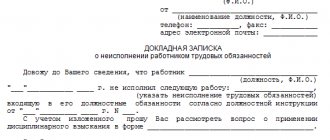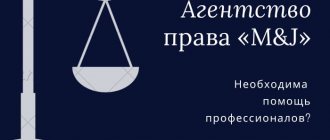Home / Labor Law / Responsibility / Disciplinary
Back
Published: 05/15/2016
Reading time: 7 min
0
3778
For failure or improper fulfillment by an employee of the requirements specified in the employment contract, the employer may apply certain penalties to the violator. According to Article 192 of the Labor Code of the Russian Federation, legal disciplinary sanctions are reprimand, reprimand and dismissal.
The application of one or another penalty in various labor disputes is regulated in the same legislative act. In this article we will consider this type of disciplinary sanction as a remark.
- Remark as one of the types of disciplinary sanctions
- Violations for which it is advisable to impose penalties
- Registration procedure
- Consequences
- What to do if an employee does not agree with the imposition of a disciplinary sanction?
Remark as a type of labor “punishment”
Having asked the question about the responsibility of employees for mistakes committed and violations of work procedures, we first of all turn to the Labor Code (LC) of the Russian Federation - we are interested in Chapter 30, Articles 192 and 193. It is here that the basics of disciplinary action are concentrated, and they are represented by three types of measures :
- a remark is the bare minimum of impact;
- a reprimand is an average measure, but in general (in its design and general consequences) it does not differ in anything other than “moral gravity” from a reprimand;
- termination of employment relations is an exceptional measure.
Let us emphasize the basic principles of applying reprimands (they are suitable for any type of collection):
- fairness - you can punish only for violation of duties (if the employee did not do something that was not part of his functions, this is not a disciplinary offense);
- guilt - when analyzing an offense, they take into account not only the employee’s attitude to the action (did he want to or didn’t want to?), but also the circumstances (could he, did he have an objective opportunity to do it?);
- proportionality - the severity of the punishment must correspond to the severity of the mistake committed;
- possibility of rehabilitation - there is a period during which the measure is relevant, but in addition, the penalty can be repaid ahead of schedule.
As you can see, the need to comply with the principles of fairness when assessing an offense and choosing a punishment puts the employer in relation to the employee on a par with the judicial body, giving him greater powers, but no less responsibility. The latter should be especially remembered - the scope of application of punishments to employees is very acute and conflict-ridden; at any moment, a competent government body can be involved in a dispute, which will evaluate every step of the employer with all the inherent severity and bias.
The use of disciplinary measures is a very conflict-ridden and “slippery” area; government agencies may well intervene in the conflict
About the choice of measures of influence
Let’s make a reservation right away: all disciplinary methods of influence indicated in the Labor Code are documented in writing, in compliance with the established procedure. An oral reprimand is not a disciplinary measure; it does not entail any consequences other than possible moral suffering and a “training” effect. In the legal sense of the word, an oral reprimand is not a punishment.
Practice shows that as an adequate response to a minor offense that does not entail serious consequences for the activities and reputation of the company (being late for the first time, failure to comply with the established dress code, insubordination, etc.), a verbal remark (warning) is quite suitable. In most cases, the measure has the desired effect and the offense is not repeated.
It is possible to apply a reprimand as an official measure of influence in compliance with the procedure and all the consequences in the case where an employee repeatedly (after one or several warnings) continues to violate work regulations or be negligent in his duties, but in general his offenses are insignificant and do not entail serious consequences. financial losses do not damage the business reputation of the company. If the company suffered significantly, there is a serious loss of profit - the choice leans in favor of a more severe measure - a reprimand. All of these, however, are only general directions for analysis and decision-making; in each specific case, the choice remains only with the employer. It may seem that the latter is authorized to “do arbitrariness,” but this is not so - the adequacy of the measures taken can be reviewed by the competent authorities, and the discrepancy between the measures of influence and the deed is punishable by an administrative fine.
For a one-time violation of the dress code, it is hardly fair to punish with a “real” reprimand; a verbal one is sufficient.
In practice, questions often arise about the application of several penalties one after another to the same employee. Analysis of the list of disciplinary measures suggests the possible sequence of their application - first a reprimand, only then a reprimand, and only then termination of employment relations. This is partly true, but this does not apply to reprimands and reprimands; a certain “procedure” is available only for dismissal (in order to qualify for this measure, the employee must already have received a penalty, but there are exceptions to this rule). The employer is free to choose, taking into account only the severity of the offense committed and the situation at the time of its commission. For example, for the first guilty mistake a reprimand may not necessarily be applied (maybe a reprimand); a reprimand may well be followed by a reprimand. In addition, the employer can apply comments and reprimands in any sequence an unlimited number of times, without resorting to the next, exclusive step - termination of the contract.
Speaking about the possibility of applying a penalty several times, one cannot fail to mention a very important, at first glance simple, but at the same time far from unambiguous in practice point - one offense should correspond to only one disciplinary punishment. However, one should not confuse a remark with other measures of influence applied in connection with it - the so-called consequences - material and moral penalties. They are applied along with the measure under consideration; their number and size are determined in the company’s local regulations.
About the consequences
Any disciplinary measure, including a reprimand, is relevant (taken into account) only for a certain period - one year. It is during the year that it will influence both payments and decisions made by management regarding the employee (the presence of a comment may also be taken into account when considering the issue of punishment for another offense; this will be considered an “aggravating” circumstance). All consequences are absolutely individual for each organization; they are established by local regulations. Like any other measure, a notice can be extinguished ahead of schedule according to a special procedure; after the expiration of the validity period, it is extinguished automatically.
My experience as a human resources specialist shows that the duration of disciplinary sanctions is still a kind of convention. As a rule, the financial consequences of the received punishment occur in the first months of its effect (each company itself establishes the procedure for depriving payments, but you can only deprive additional payments - allowances and bonuses, and more often it happens that they are deprived not for the whole year). In our organization, local regulations provide for a reduction in the premium for professional excellence by 50% for the month in which the penalty is announced, and partial deprivation of some annual bonuses. The moral consequences of punishment are not limited to the established year - a record of the penalty is constantly stored in the employee’s card, and although after its expiration it is not taken into account in the legal sense (for example, the employee can again be awarded a certificate of honor and gratitude based on the results of work for the year), but The employee will never be considered “having no penalties” at this place of work. The remark that took place every now and then “pops up” in the objective reference, which means it can play its “evil” role at the time of comparison, all other things being equal.
The remark may affect the monthly amount of payments to the employee (however, it all depends on the rules established in the company)
About the terms of bringing to responsibility
While protecting the rights of the employee, the law somewhat limits the employer in the time frame for making and processing a decision on a misdemeanor. The deadline in this case is somewhat unusual - it is “double”, there are two points of reference for it:
- The first is the date when the misconduct became known. From this moment until the announcement of the measure, the employee has a maximum of one month left. But the deadline can be extended for reasons such as the absence of an employee due to illness or vacation days, the need to find out the opinion of the trade union if it is delaying.
- The second reference point is the actual date the worker committed a culpable mistake. From this moment until punishment, a maximum of six months (for the general case) or two years (for a violation discovered during the inspection) can pass. This period will not be extended.
A correctly calculated period takes into account two reference points, otherwise the penalty will simply be unlawfully imposed. There are also frequent cases where two starting points coincide (for example, an employee made a mistake, which immediately became known to the public and, most importantly, to the administration) - then no difficulties arise with calculating deadlines.
Special deadlines are established for offenses (violations by an employee of relevant labor functions, if he has them) in the field of anti-corruption. Up to three years may pass from the date of the error; the period is interrupted by the period spent on investigative actions.
Consequences of disciplinary action in the form of a reprimand for an employee
For an employee who has received a punishment for work, the following scenarios are possible:
- Loss of bonus. If an internal local act provides for a reduction in bonuses for misconduct, in addition to receiving a reprimand, the employee loses a bonus.
- Possibility of dismissal. The boss has the right to terminate the employment contract with an employee who has been subjected to disciplinary action twice in a year (Clause 5, Part 1, Article 81 of the Labor Code of the Russian Federation).
- Removal from work. Employees of government agencies who receive reprimands may be temporarily suspended from work.
- Obstacles in career growth. When considering promotion, disciplinary action may affect your ability to obtain a new title or position.
Registration of collection
As noted, disciplinary “punishments” are an area of high responsibility for the employer, so he is required to be truly precise in execution. The main stages follow from the norms of Art. 193 TK:
- Recording the offense or the fact of its discovery (act, report, inspection certificate, etc.). The mandatory presence of such a document follows from the legislator’s regulation of clear deadlines for bringing to justice.
- Requesting an explanation from the offender (the request can be made orally or in writing, an explanatory statement must follow in writing). If resistance is detected, this fact should be recorded in an appropriate act.
- Announcement of management's decision by order.
- Familiarization of the offender with the document against signature. In case of refusal, the act is repeated.
- Making entries about the presence of penalties in accounting documents (T-2 form card, software systems, etc.).
In our organization, the process of imposing disciplinary action is always under the strictest control of the head of the HR department. After all, it is the documents on penalties that are primarily requested by inspectors (in each case of inspection - both internal and external). Particular attention is paid to the timing of the implementation of measures, but there are often cases when, due to protracted checks on the fact of a violation by the security service, an order is issued exactly on the last day of the deadline (and even then with great difficulty).
Let's look at each stage of announcing a comment in more detail.
Recording a violation
The law does not oblige the employer to draw up any specific document in case of detection of a violation on the part of an employee - it all depends on the situation and the rules established within the company itself (LLA or simply traditions). Possible options:
- A memorandum from the head of a structural unit (optionally, not even the one in which the employee works, perhaps from the security service, etc.) or the employee himself. The report is drawn up in the name of the manager authorized to make personnel decisions. The document sets out the essence of the incident and a request to take action (possibly proposals for the type of penalty).
The memo addressed to the manager describes the incident in detail, formulates requests - to take action, bring them to justice, etc.
- The report is most often drawn up in the event that an employee is absent from work or appears there in poor condition. Such violations may also result in a reprimand (it all depends on the will of management), therefore this method of recording is acceptable.
The act can be drawn up in any form
The main difference between the act and other documents is that it is drawn up in the presence of several people at once (preferably at least three persons). In addition, the act, as a rule, does not contain a request to management to apply a penalty, but can be used for management to impose a resolution on its own or as an appendix to a memorandum.
- Verification certificate. This document is drawn up by an authorized official during a scheduled or unscheduled audit. The form of the certificate is arbitrary or established in the organization to which the inspector belongs.
An inspection certificate can be drawn up either by a government agency or by an internal inspector authorized to do so by the company’s local regulations
The inspection certificate may suggest measures to be taken against the perpetrators. Based on the results of reviewing the certificate, the head of the company issues a resolution requesting clarification.
Explanations
In order for the employer to see an objective picture of what happened, the law strictly obliges him to receive and consider the explanatory note of the offending employee.
Before imposing disciplinary action, the employer must request a written explanation from the employee. If after two working days the employee does not provide the specified explanation, then a corresponding act is drawn up.
Legislator
Labor Code of the Russian Federation, Part Art. 193
In practice, clarification is often requested verbally, but in complex and controversial cases it is better to make a request.
The request can be submitted against signature, but this is not necessary.
It seems reasonable to make a request and hand it over against signature if it is expected that the employee will refuse to provide explanations. This will be proof of his notification of the commenced process and will additionally fix the deadline for writing an explanatory note.
The explanatory note is drawn up by the offender himself (by hand or using computer technology). In it, he must describe in as much detail as possible all his actions subject to censure, provide arguments in his justification or admit guilt.
An explanatory note is written addressed to the head of the company and signed by the offending employee in his own hand.
In practice, there are often situations when a conflict over a violation is aggravated to the limit - the employee does not want to admit that he was wrong and completely refuses to give explanations or sign documents. If, after two days from the date of request, no explanations have been received from the employee, it is time to draw up a statement of refusal. Drawing up this document is mandatory - it will replace the explanatory note and testify to the position of the guilty employee.
The act is drawn up in any form, the main thing is that in addition to the compiler, two more witnesses sign on it. It is better to draw up the report in the presence of the guilty employee himself, by reading out loud the circumstances of the case and once again asking whether the employee is going to give an explanation. This is necessary so that both the witnesses and he understand the essence of what is happening.
The act of refusal is drawn up in any form
It is on the explanatory document (or act) that the head of the company must impose a resolution containing a decision on the case - apply a reprimand or other type of disciplinary punishment to the offender (as an option - simply deprive the bonus or verbally warn about the inadmissibility of such actions).
Order
The decision to impose a penalty itself takes the form of an order. The document is drawn up in any form, but must contain a clear description of what happened (what was the employee punished for?) and the name of the chosen penalty.
The order is signed by the head of the company
It is important to strictly adhere to the deadline for familiarizing the perpetrator with the order - three working days (the period is extended if the employee is absent). In case of refusal, a report is also drawn up.
The act of refusal to familiarize yourself with the order is also drawn up collectively
After reviewing the administrative document, the procedure for announcing a comment ends. The HR officer only needs to make entries in the relevant documents.
Entering data into documents and software systems
The law does not establish a mandatory method for recording comments (other disciplinary sanctions), however, the existence of records is still necessary in order to strictly apply the consequences of penalties to the employee, as well as their timely removal.
Contrary to a common misconception, an entry about a reprimand (or other penalty) is not made in the work book.
There is no column for marking disciplinary offenses in the T-2 form registration card. But if the organization does not have specialized personnel software systems, and employee data is kept track of by filling out such cards, then information about the comment can be placed in the “Additional information” column.
Information about penalties can be entered in the “Additional information” column
Some organizations keep a log of disciplinary actions taken.
Keeping a collection log is not necessary, but it is very convenient if the organization does not have specialized software
In the company where I work, throughout its existence, we have used two types of specialized HR software (Workstation “Personnel”, SAP). Both programs make it possible to effectively process data on disciplinary sanctions - they necessarily “pull” information about misconduct into a “lens” certificate, and warn about the presence of unresolved punishments in other reports. The SAP system also makes it possible to issue the order to apply the measure automatically - only by entering all the necessary data into the complex.
When can a disciplinary sanction be applied in the form of a reprimand?
Any culpable violation of labor discipline may entail disciplinary liability—it is up to the employer to decide whether to impose it or not. Art. 192 of the Labor Code of the Russian Federation provides for three main measures of influence on workers:
- Comment. This is the most loyal type of punishment. As a rule, it is imposed for being late for work, engaging in extraneous activities at the workplace, or when employees commit other minor violations of labor discipline.
- Rebuke. Perhaps the most popular punishment for misdemeanors. It is also applied in cases of improper performance of labor duties. For example, for the release of defective products, refusal to perform official duties.
- Dismissal from work. The most severe disciplinary measure applied for the most serious violations, such as absenteeism, coming to work under the influence of alcohol or drugs, theft in the workplace.
For certain positions, the legislation establishes other types of disciplinary liability. For example, for prosecutorial employees, a reduction in class rank, a warning about incomplete official compliance (Part 1, Article 41.7 of the Law “On the Prosecutor's Office...” dated January 17, 1992 No. 2202-1) can be applied as punishment.
Removing a comment
A reprimand, like any disciplinary punishment, has two methods of repayment (Article 194 of the Labor Code):
- automatic - after the expiration of the one-year period, without any documentation, the measure ceases to be valid (if the employee has not “earned” a new one);
- early - in connection with the rehabilitation of the employee, at the request of his immediate management, the employee himself or the trade union, the administration can lift the penalty, but registration will be required.
Arranging for early “exemption” from a reprimand is quite simple:
- A memo will be required describing all the latest professional achievements of the offender. It would be good to emphasize in the text of the document that the culprit admitted his mistake, corrected it (it is better to provide evidence of this fact), and does not allow this to happen over a long period of time. The note is drawn up in the name of the manager and must contain a request to remove the penalty. The leader, by his resolution, expresses his will - to satisfy the request or refuse it.
In the memorandum on the lifting of a penalty, it is important to justify the need to “encourage” the employee
- Following the receipt of a note with a positive resolution from management, the HR department prepares an order to lift the penalty. Its shape is arbitrary. After signing by the manager, the employee should be familiarized with the administrative document, however, the law does not contain a direct indication that familiarization is mandatory (but problems with familiarizing with such an order are unlikely to arise).
The order to remove the remark is drawn up in any form
If the notice was removed automatically, there is no need to make any notes about it in the documents, but if it was done ahead of schedule, it is better to note it in all journals, cards and software systems so as not to forget.
Consequences
Neither remarks nor reprimands are entered in the employee’s work book. But these disciplinary sanctions, like dismissal, have serious consequences.
After a single minor violation, followed by a reprimand, an order is drawn up.
It is valid for 1 year. If during this period the employee did not commit any offenses, then such a disciplinary sanction does not carry any consequences.
But repeated even minor offenses, followed by a reprimand or reprimand, can lead to the dismissal of an employee. This disciplinary sanction will be included in the work record book. This can lead to problems in subsequent employment.
Increase in military pensions in 2021 - what to expect? How much sick leave can you expect if you have had your appendicitis removed? In our material you will find the information you need.
You can find out everything you need about gray wages in the article at this link.
Appealing a comment
Quite often, employees do not agree with the penalties applied to them. Art. 193 of the Labor Code gives the employee the right to seek protection:
- to the state labor inspectorate - the inspectorate will conduct an inspection based on the complaint and may issue a mandatory order for the employer to comply with and impose penalties on the organization;
- to the labor dispute commission (there is a period of three months) created at the enterprise; the decisions of this commission are binding on the employer;
- to court - if you disagree with the decision of the commission.
What is the impact of a comment?
Any disciplinary sanction is unpleasant for the employee both from an economic and psychological point of view. The first remark usually significantly reduces work enthusiasm and reduces production performance . But there are also advantages: subordinates who have been “at fault” show more responsibility in the production process, closely monitor the work schedule and improve their own skills.
This is also important to know:
How and by whom a petition to lift a disciplinary sanction is filed
A competent leader, before punishing a subordinate, must assess the possible consequences. If we are talking about a minor offense, then sometimes you can get by with an ordinary conversation.
Through disciplinary punishments, you can influence both an individual employee and the team as a whole.
In accordance with the Labor Code, a remark made orally does not entail any legal consequences for the employee. If the head of a department wants to bring an employee to disciplinary liability, he needs to send a report or memo to the head of the organization.
Rationale. For some categories of workers, for example, for employees of internal affairs bodies, it is provided for the announcement of a reprimand or reprimand publicly orally (Decree of the President of the Russian Federation of October 14, 2012 N 1377 “On the Disciplinary Charter of Internal Affairs Bodies of the Russian Federation”).
However, by virtue of Art. 193 of the Labor Code of the Russian Federation, regardless of what disciplinary measure the employer has chosen, it must be expressed in an order signed by the employer represented by the head of the organization. The order is announced to the employee against signature within three working days from the date of publication. This document contains the following information: last name, first name, patronymic of the employee subject to disciplinary liability, the content of the disciplinary offense, the type of disciplinary sanction and details of the document confirming the commission of this offense (for example, a report or act of disciplinary offense).
A comment made orally does not entail any legal consequences. That is, if an employer wants to prosecute an employee for repeated failure to fulfill work duties without good reason in the presence of a disciplinary sanction, this will be unlawful.
As for the right to bring to disciplinary liability, it is possessed by the employer represented by its executive body - the manager, who, among other things, signs the order to impose a penalty. The employer, represented by the founders of the organization or the authorized body specified in the organization’s charter, which contains information about the competence of the management bodies, will bring the manager himself to disciplinary liability.
The head of the department may impose a penalty if such authority is granted to him by the employer. Of course, he has the right to make an oral reprimand to an employee who is directly subordinate to him in any case.
Free legal consultation
We will answer your question in 5 minutes!
Free legal consultation We will answer your question in 5 minutes!
Call: 8 800 511-39-66
Ask a Question
How to respond to fair criticism
Accept criticism. The simplest thing is to agree with the comments without showing guilt, making excuses or apologizing. We all make mistakes, and the best thing to do is admit the mistake, correct it, draw the necessary conclusions and move on. They say that those who do nothing make no mistakes.
Manager: “You didn’t do the task very well.” You: “Yes, I agree. I’ll try to change it.”
Ask for more information. Another option is to accept the negative feedback but immediately ask for more information from the critic. Ask any clarifying questions—absolutely any—about what you hear. In fact, it doesn't matter what you ask - with this technique you "dilute" the criticism and demonstrate that you are confident and in control of the situation.
Manager: “You didn’t conduct the meeting very well.” You: “Yes, it wasn’t very effective. In your opinion, did the problems arise at the beginning of the meeting or later?”
To whom can I announce
Labor discipline, that is, the rules prescribed in the PVTR, apply only to employees.
In other words, for persons with whom an employment contract has been concluded in accordance with the established procedure. Material on the topic How to properly certify a copy of a work book, sample And it can be anything, including urgent. That is, recovery in the form of a reprimand is possible only after the start of the employment relationship. And until they stop.
If the work is performed on the basis of GPC agreements, it is impossible to issue a reprimand to such an employee. The civil law nature of the relationship does not provide for the subordination of the contractor to the requirements of work discipline.
While for the employee, compliance with them is the main responsibility. Therefore, any punishment imposed within the framework of a contract or paid provision of services is illegal.
What is disciplinary punishment
During the course of his/her work activity, an employee is obliged to fulfill the job duties assigned to him/her, preserve the employer’s property and comply with the established routine. If these requirements are not met, the employee is subject to punishment. The duration of the disciplinary sanction is one year, and it is imposed for an offense related to work activity.
Disciplinary offenses include:
- failure to fulfill official duties;
- negligent or incomplete performance of assigned work;
- non-compliance with the established work schedule - lateness, absenteeism, leaving the workplace early;
- causing damage to the employer's property;
- disclosure of trade secrets;
- violation of safety regulations, regardless of the consequences;
- failure to comply with instructions for using equipment;
- refusal to improve qualifications or training if this is provided for in the job description or professional standard.
Depending on the field of activity and the characteristics of production, the procedure for applying disciplinary sanctions and the list of violations will change. They must be prescribed both in the collective labor agreement and in individual instructions for positions and types of activities.










